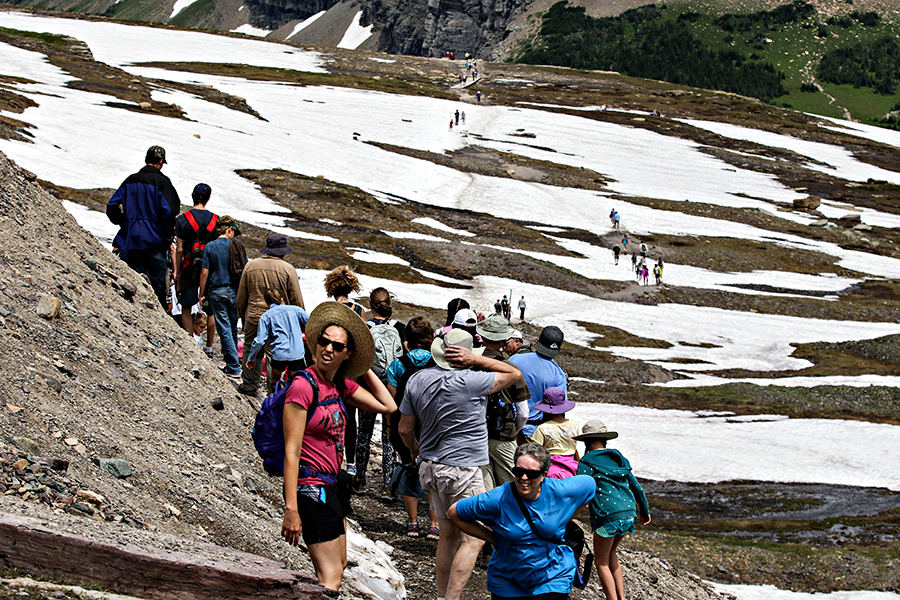When summertime hits the Flathead Valley, it’s impossible to ignore the role tourism plays in the valley’s economy – the roads are full of cars and RVs, the campgrounds and hotel rooms are bustling, and Glacier National Park is packed with folks looking to get to know their national playground.
Millions of people stream into the Flathead during the summer, with adventure on their minds and plenty of money in their wallets. The question for local business and tourism-based organizations is, how do we most effectively drink from what has become a fire hose of economic activity?
That was the basis of a panel discussion at a recent Kalispell Chamber of Commerce luncheon, where leaders from various facets of the tourism industry discussed how to best take advantage of the natural magnetism of this place. The panel included Dawn Jackson with the Kalispell Convention and Visitor Bureau; Jeff Mow, superintendent of Glacier Park; Jeri Moon of the Northwest Montana Association of Realtors; and Alisha Shilling of Kalico.
Diane Medler of the KCVB moderated, and noted that accommodation, access, arts and culture, and authenticity are the buzzwords for tourism trends, and that the Flathead Valley is well situated to capitalize on them.
“People come here for the vacation that we get to live every day,” Medler said.
In 2018, more than 12 million non-resident visitors spent $3.72 billion across the state, according to the Institute for Tourism and Recreation Research. Locally, 2.7 million visitors spent $530 million in Flathead County, with Glacier Park as a major driver of that traffic.
Glacier’s visitation numbers remain consistently high, with 2.9 million visitors in 2018 and 3.3 million in 2017. Mow, the park superintendent, said 2017 set the bar for visitation, and though last year saw a 10 percent decrease in the number of visitors to the park, those who did visit spent 25 percent more than the visitors in 2017. Park visitation to date is up 13 percent over last year at this time, with April seeing a 25 percent jump in visitation and March up 10 percent.
“Glacier plays well in the sandbox of social media,” Mow said of the park’s growing popularity.
The park is attracting new kinds of visitors, he said, with classifications such as “selfie tourism” and “last chance tourism,” meaning those who have heard about climate change’s impact on the park’s glaciers and want to see them before they disappear.
Mow said the question his team asks is how they can help with visitor expectations in the park, and so far that has been through webcams showing the park’s congestion levels, as well as social media updates about parking. Mow also said the new Recreational Access Display will be updated every five minutes and shows the status of all campgrounds, the weather, and times these places fill up every day, and will be shown in breakfast rooms and lobbies in hotels around the valley to keep people updated.
While the park is one of the main tourism drivers, the panel also discussed other trends in visitation. Shilling, with the Kalico group seeking to develop an arts and cultural center for Kalispell, said millennial travelers value cultural experiences in their travel.
“Cultural tourists pay 60 percent more on their trips,” Shilling said.
Shilling said there’s a social shift away from corporate experiences and one toward authenticity, and Kalispell is a perfect place to grow such expectations with its art community and general friendliness to travelers.
Jackson, with Discover Kalispell, said the valley has reacted to the increase in tourism by adding 600 hotel rooms since 2016, bringing the valley’s total to 3,451 hotel rooms counting Bigfork, Kalispell, Whitefish, and Columbia Falls. Those numbers don’t include short-term rentals.
While everyone knows the bread and butter of tourism season is the summer, Jackson said the KCVB and other organizations have been working to grow that into the shoulder seasons.
“We feel like we’re seeing that in the park,” Mow said.
Jackson also said more people are booking their activities online, and that more direct flights to and from Glacier Park International Airport have added to the area’s tourism economy.
One aspect the community lacks is a meeting space that can accommodate 750 people with smaller rooms for about 200 people, Jackson said, which limits the types of conferences and meetings that can be scheduled here.
When people come to visit for business, it’s an opportunity to impress potential repeat visitors, she said. And Moon, with NMAR, said many of those people who fall for the valley as visitors end up buying property here, contributing to another aspect of the local economy.
Mow said the park will continue to grapple with visitation and wildfire issues, both of which affect congestion, and that the park is taking an “all hands on deck” approach as it moves forward.
“It really will take a lot of partnerships and collaboration and philanthropy,” Mow said.
